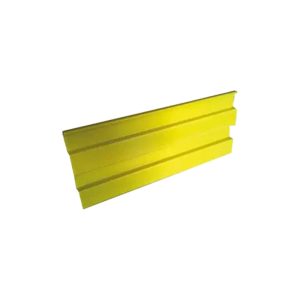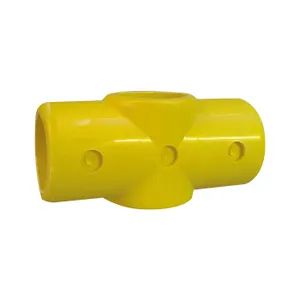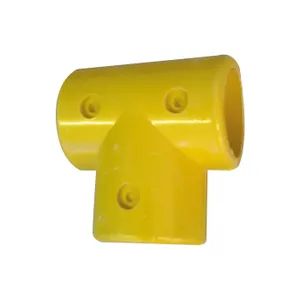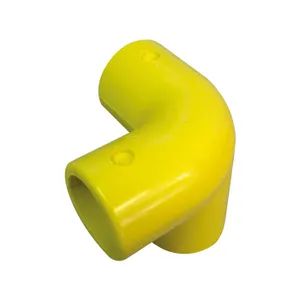我们的 GRP 扶手系统通常用于 GRP 扶手或护栏,以在 90° 角上延续中间栏杆或将垂直柱连接到顶部栏杆,或将中栏杆连接到端柱。
产品性能介绍
|
|
GRP 外部旋转接头是一种多功能的直列式旋转接头,通常用于斜坡、台阶和平台上角度不同的地方。 |
|
GRP 116 Mid Corner 是一种 90° 转角接头,常用于 GRP 扶手或护栏,以在 90° 转角处延续中间栏杆,但也可用于构建矩形或方形结构。立柱垂直穿过 GRP 配件。通常与 GRP-128 顶角一起使用。 |
|
|
GRP 101 短三通是 90° 三通连接,通常用于 GRP 扶手,以将垂直柱连接到顶部导轨,或将中轨连接到端柱。管子不能连接到配件的顶部 - 如果需要,可以使用 GRP-104 长三通作为替代品。 |
|
GRP Fitting 119 Midrail Cross 是一个 90° 接头,通常用于将中间栏杆连接到 GRP 扶手或护栏中的中间立柱。立柱垂直穿过 GRP 配件。 |
|
|
GRP 104 长三通是 90° 三通连接,通常用于将垂直立柱连接到 GRP 扶手的顶部导轨。 GRP -104 可用于需要在接头顶部连接两根管子的地方。 |
|
GRP 125 配件是一个 90° 弯头,通常用于 GRP 扶手或护栏,以在跑步结束时将顶部栏杆连接到立柱。 |
|
|
GRP 129 是一种 30° 的三通接头,通常用于楼梯 GRP 扶手或护栏。 |
|
128 Top Corner 接头是三向接头。 90° 弯头,通常用于将直立柱连接到 90º 拐角处的 GRP 扶手的顶部栏杆。通常与 GRP-116 中角一起使用。 |
|
|
GRP 130 是一个 30° 十字,通常用于将中轨连接到楼梯 GRP 扶手中的中间柱。 |
|
GRP 116 Mid Corner 是一种 90° 转角接头,常用于 GRP 扶手或护栏,以在 90° 转角处延续中间栏杆,但也可用于构建矩形或方形结构。立柱垂直穿过 GRP 配件。通常与 GRP-128 顶角一起使用。 |
|
|
GRP 132底板是带有四个固定孔的底板,用于固定扶手或护栏中的立柱。 |
|
GRP 173 单旋转接头是一款多功能旋转接头,适用于斜坡、台阶和平台角度不同的情况。 |
|
|
145 墙壁插座是一种 GRP 配件,设计用于将 GRP 扶手或护栏侧面固定到墙壁、坡道和台阶上。 |  |
我们的 GRP 踢脚板宽 100 毫米,壁厚 5 毫米。它有 6 米长的库存,但如果需要可以切割成一定长度。 |
中国制造的玻璃钢 (GRP),TFcomposite 的 GRP 扶手系统提供了优于钢材的主要优势,这解释了为什么从水处理厂到铁路行业,到处都会看到 GRP 扶手。
玻璃纤维增强塑料 (FRP) 扶手系统是一种先进、耐用的解决方案,适用于工业、商业和建筑领域的安全防护和通行。它们以强度高、耐腐蚀、维护成本低而著称,因此非常适合传统材料(如钢材或木材)可能因暴露于恶劣环境而失效的场所。以下将深入探讨 FRP 扶手系统,包括其组成部分、优势、应用、安装流程和维护保养。.
1. 什么是FRP扶手系统?
FRP扶手系统是一种模块化或预制的安全护栏系统,由玻璃纤维增强塑料制成,这种复合材料将高强度纤维与聚合物基体结合在一起。因此,该产品具有轻质、坚固、耐腐蚀、耐化学品和耐紫外线照射等优点。.
关键组成部分
FRP扶手系统通常由以下部分组成:
- 铁路水平构件提供持续支撑。.
- 帖子:固定在地面或建筑物上的垂直构件,用于支撑铁轨。.
- 膝部护栏:辅助水平导轨,用于提供额外的支撑和安全性。.
- 鞋头板:防止工具或碎屑掉落的基础组件。.
- 配件将系统固定在一起的连接器、支架和紧固件。.
- 底座和支架用于将系统固定到地板、墙壁或其他表面上。.
2. 材料与制造
FRP扶手系统主要采用两种制造方法生产:
- 拉挤成型:
- 连续纤维被拉过树脂槽和加热的模具。.
- 确保强度均匀,表面光滑。.
- 成型:
- 将玻璃纤维毡或编织粗纱分层铺放,并在模具中注入树脂。.
- 常用于复杂或定制形状。.
FRP扶手常用材料
- 纤维通常采用玻璃纤维以获得高拉伸强度。.
- 树脂类型:
- 聚酯纤维:经济实惠且具有一定的耐化学性。.
- 乙烯基酯具有更高的耐化学性和耐热性。.
- 环氧树脂:优异的机械强度和粘合力。.
可以添加紫外线抑制剂、阻燃剂和颜料等添加剂来增强性能和美观性。.
3. FRP扶手系统的主要优势
FRP扶手系统相比传统材料具有以下几个优点:
3.1 耐腐蚀性
- 适用于易受化学品、盐水或潮湿环境。.
- 用于污水处理厂、海洋应用和化学加工设施。.
3.2. 轻便易安装
- 重量比钢或铝轻得多,从而降低了运输和人工成本。.
- 模块化设计通常无需专用工具即可轻松组装。.
3.3 高强度重量比
- 与传统材料相比,它具有相当或更优异的强度,且体积更小。.
3.4. 耐用性和使用寿命
- 不易开裂、变形和老化。.
- 即使在极端条件下也能保持较长的使用寿命。.
3.5. 低维护成本
- 无需油漆或频繁检查。.
- 抗锈蚀和生物生长。.
3.6 电气和隔热
- 不导电,因此在电气环境中安全。.
- 低导热性可降低高温环境下的烧伤风险。.
3.7 可定制性
- 提供多种颜色、尺寸和配置,以满足特定需求。.
- 美观的选择增强了与建筑设计的兼容性。.
4. FRP扶手系统的应用
由于其适应性和坚固性,FRP(玻璃钢)扶手被广泛应用于各个行业。以下是一些主要应用领域示例:
4.1 工业设施
- 化工厂能够承受化学品飞溅和烟雾。.
- 石油和天然气:无腐蚀性确保其在海上和陆上设施中的使用寿命长久。.
- 发电厂:不导电特性为变电站提供安全保障。.
4.2 水和污水处理厂
- 耐氯、耐酸、耐湿。.
- 非常适合用于走道、平台和储罐通道。.
4.3 海洋和沿海环境
- 不受海水腐蚀的影响。.
- 用于码头、栈桥和海上平台。.
4.4 公共基础设施
- 桥梁、公园和人行道,安全性和美观性至关重要。.
4.5. 商业和住宅
- 阳台、楼梯和坡道需要现代化的、低维护成本的栏杆。.
5. 设计标准和合规性
FRP扶手系统通常按照严格的安全和工程标准设计,包括:
-
美国职业安全与健康管理局 (OSHA):
- 确保符合工作场所扶手安全准则。.
- 需要具备特定的高度、强度和挠度特性。.
-
美国材料与试验协会 (ASTM):
- 提供强度、耐久性和材料性能的测试标准。.
-
ISO(国际标准化组织):
- 涵盖全球质量和环境安全标准。.
-
ADA(美国残疾人法案):
- 强制要求扶手具备无障碍功能,例如光滑的表面和适当的高度。.
6. FRP扶手系统的安装
安装FRP扶手系统包括以下步骤:
6.1 准备工作
- 评估现场条件,确保表面清洁平整。.
- 根据预先批准的布局或工程设计标记安装点。.
6.2 装配
- 在标记点安装底座或支架。.
- 使用螺栓或粘合剂将立柱固定到底座上。.
- 使用支架和紧固件将横梁和膝梁固定到立柱上。.
- 必要时安装踢脚板。.
6.3. 完成
- 拧紧所有连接件并检查对齐情况。.
- 如果需要额外保护,请涂抹密封剂或涂层。.
6.4 安全测试
- 进行负载测试,以确保符合安全标准。.
- 检查是否有松动或错位。.
7. FRP扶手系统的维护
FRP系统几乎不需要维护,但定期检查可以确保其发挥最佳性能:
7.1 清洁
- 使用温和的肥皂和水去除污垢、碎屑或油脂。.
- 避免使用研磨性材料,以免刮伤表面。.
7.2 检查
- 检查配件、螺栓是否松动,材料是否有裂缝。.
- 定期检查接头和连接处。.
7.3. 维修
- 损坏的部件通常可以单独更换,而无需拆卸整个系统。.
- 请使用兼容的粘合剂或制造商提供的替换零件。.
8. 自定义选项
FRP扶手系统具有高度可定制性,能够适应特定需求:
- 颜色:黄色、绿色、灰色或自定义颜色,用于品牌推广或安全编码。.
- 尺码:改变轨道直径和立柱高度以满足特定要求。.
- 表面处理:
- 为了美观,表面光滑。.
- 表面纹理设计,防滑。.
9. 成本考量
虽然FRP(玻璃钢)扶手的初始成本可能高于传统材料,但其长期成本效益使其成为一种颇具吸引力的选择。主要成本因素包括:
- 材料等级(聚酯与乙烯基酯)。.
- 定制需求。.
- 安装复杂度。.
- 项目的数量和规模。.
10. FRP扶手系统与传统材料的比较
| 特征 | FRP扶手 | 钢制扶手 | 铝合金扶手 |
|---|---|---|---|
| 耐腐蚀性能 | 出色的 | 贫穷的 | 缓和 |
| 重量 | 轻的 | 重的 | 轻的 |
| 维护 | 低的 | 高的 | 缓和 |
| 力量 | 高的 | 很高 | 缓和 |
| 电导率 | 非导电性 | 导电 | 导电 |
| 成本(初始) | 中等至高 | 低至中等 | 高的 |
| 成本(终身) | 低的 | 高的 | 缓和 |
11. 未来趋势
- 提升美观度:用于现代设计的新型颜料和涂料。.
- 可持续发展使用可回收或环保树脂。.
- 智能系统:将物联网传感器集成到安全监控中。.
结论
对于需要耐用性、安全性和低维护成本的行业和环境而言,FRP(玻璃钢)扶手系统是理想之选。与传统材料相比,FRP扶手具有更强的适应性和更优异的性能,使其成为基础设施和工业设施的长期投资。凭借其模块化设计、易于安装和可定制性,FRP扶手在各种应用领域中持续受到青睐。.
FRP扶手系统详细概述
系列 :
主要产品 >应用场景
我们的玻璃钢扶手系统广泛应用于玻璃钢扶手与护栏的多点直连交叉连接。
品牌 :
TF复合
颜色 :
黄色或灰色
常问问题
问:
GRP 扶手管的尺寸和长度是多少?
答 :
GRP 管仅以 50mm o/d(外径)生产,并以 5m 的长度库存。如果需要,我们可以将管子截短。
问:
配件是如何固定在管子上的?
答 :
GRP 扶手的配件作为两个相同的半部分提供,它们简单地夹在管子周围。这些需要使用标准的 9 毫米直径 HSS 钻头(随您的订单提供)在现场钻孔,并与提供的特殊不锈钢铆钉固定件用螺栓固定在一起。然后使用 pozi 3 螺丝刀插入并拧紧螺栓,在拧紧螺栓时,滚花铆钉固定装置将固定到位。这些固定件表面平整,没有突出的螺栓头。
问:
GRP 扶手系统有哪些颜色可供选择?
答 :
我们将管子和配件库存为黄色(以提高可见度)或灰色。
其他相关产品

























